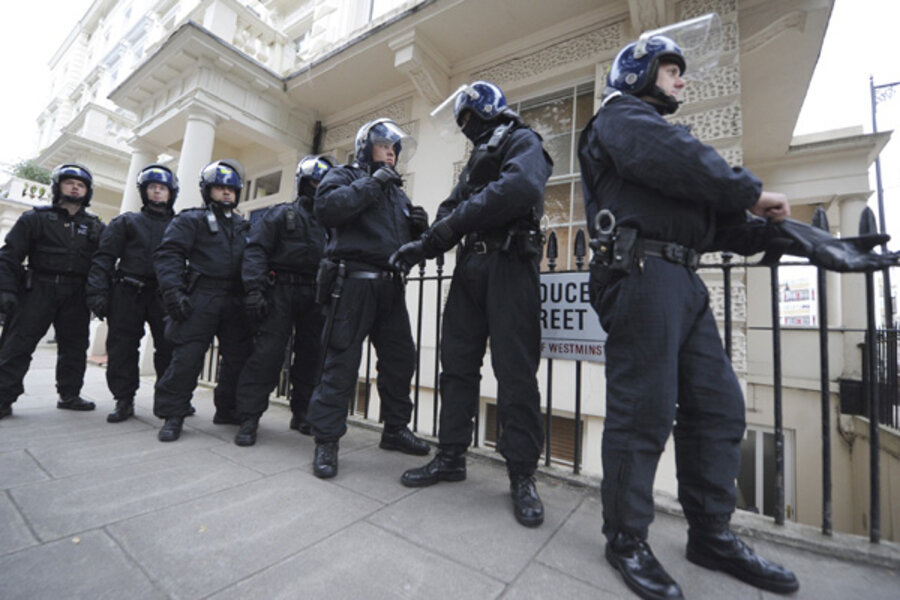After London riots, a UK war on gangs
Loading...
| London
The Cherry Boys, All ’Bout Money, Catford Wildcats, Organized Crime: These are the names of a few youth gangs in South London, part of an estimated 170 active gangs in the United Kingdom.
Prime Minister David Cameron holds gangs like these partially responsible for the four nights of mayhem and looting that rocked London and several other English cities earlier this month after suspected gangster Mark Duggan was shot dead by police on Aug. 4.
Mr. Cameron’s now vowing a “concerted all-out war on gangs and gang culture.”
“This isn’t some side issue,” Cameron said days after the riots. “It is a major criminal disease that has infected streets and estates across our country. Stamping out these gangs is a new national priority.”
Cameron has asked former Los Angeles, New York, and Boston police commissioner Bill Bratton to help enact tough antigang measures. Yet, while Cameron gears up to pursue an aggressive set of law-and-order tactics, groups with experience battling gang violence in London say a more multifaceted approach is needed.
“It’s easy to give knee-jerk reactions and place an emphasis on law enforcement, but that doesn’t get to the cause of why people join gangs,” says Nick Mason, at the Growing Against Gangs (GAG) project that works with young students to deter gang membership. “The Prime Minister talks about ‘zero tolerance’ which people like [Mr. Bratton] advocate, but that is massively resource-intensive compared to our project.”
Bill Bratton’s ‘zero tolerance’ approach
Youths needed to fear the police and possible punishment, Bratton told the Daily Telegraph newspaper.
“You want the criminal element to fear them, fear their ability to interrupt their own ability to carry out criminal behavior, and arrest and prosecute and incarcerate them,” said Bratton. “In my experience, the younger criminal element doesn’t fear the police and have been emboldened to challenge the police and effectively take them on.”
This emphasis on confrontation worries gang workers such as Mr. Mason. Working with the London police, staff at his GAG group speak to students aged between nine and 12 – when they are most susceptible to joining gangs – about the consequences and myths of membership. Over the past 18 months GAG has spoken to more than 3,700 children at 55 schools in five south London boroughs. It plans to expand the project across another 10 boroughs in the next 18 months.
“Prevention is better than cure and a lot cheaper. We’ve worked out that it costs around £1 [$1.65] per child, but if you compare that to putting someone through the criminal justice system and he gets a 12-month sentence, that can cost £150,000 [$248,242]. If someone is stabbed, that can cost the National Health Service £150,000 [$248,242]. So it makes sense to deter gang membership in the first place.”
Facilitators speak to pupils in intensive sessions, bringing in professionals such as surgeons to explain the consequences of stabbings and shootings, or former gang members on how prison affects inmates.
Gang violence has been ignored by the government and the public, says Christian Guy, director of policy at the Centre for Social Justice think tank.
“A lot of these gangs come from badly deprived areas with high unemployment and little hope,” he says. “The gang members have usually never worked or come from homes where parents have never worked. Their families are poor, anarchic, chaotic and often violent – and ironically gangs offer them a home and stability. After [the riots], the justice system has to take its course, but just arresting people is not the answer, because ... gang members who go to prison often come out martyrs and looking stronger.”
The allure of gang life
Indeed, gang life continues to hold an allure. In the poor South London neighborhood of Stockwell, single mother Doreen White worries about her two boys, ages 11 and nine.
“The gangs are out there and I know my boys will come across them at some point,” says Ms. White. “They’re threatening and have their own codes. They’ve got money and power and you can see why some kids get attracted to them because there’s nothing much else ’round here.”
Next to a memorial for young man recently shot dead in what was suspected to be a gang-related killing, a group of youths on bikes circle on the pavement.
“I don’t care what the government says, they can’t just get rid of gangs because they’ve been here for years. They fight for our area and have a lot of money and power and look after people,” says a 15-year-old who would only give his street name, Banzo. “There’s not much to do in Stockwell so we hang around and the police have a go at us. We know who the gangs are, and you don’t cross them or disrespect them."
[ Video is no longer available. ]





